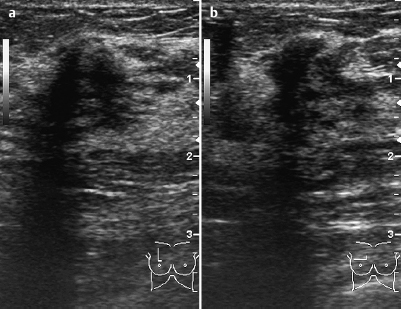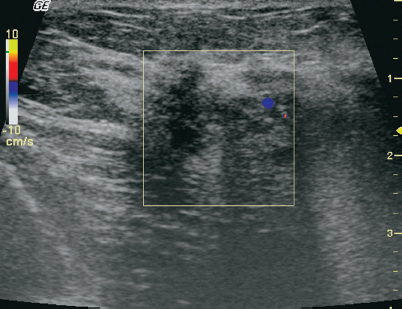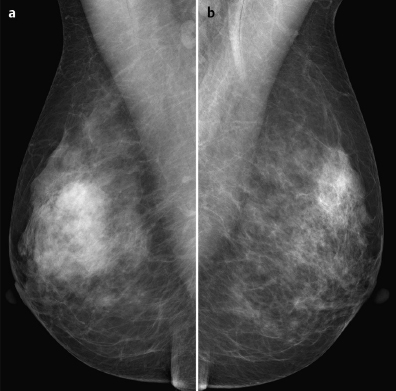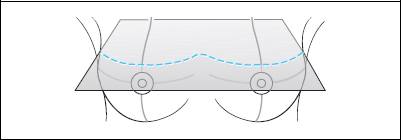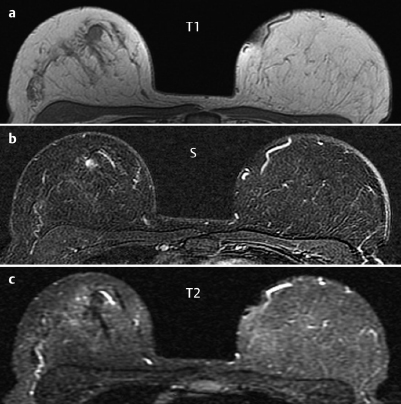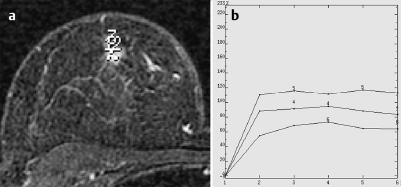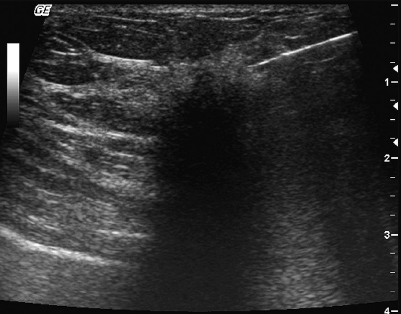Case 21 Indication: Screening. History: No abnormalities. Risk profile: Breast cancer in sister at the age of 60 years. Age: 59 years. Nodular parenchymal texture at palpation. No resistance. Fig. 21.1 a, b Ultrasound. Fig. 21.2 Color-coded Doppler sonography between the upper quadrants of the right breast. Fig. 21.3a,b Digital mammography, CC view. Fig. 21.4a,b Digital mammography, MLO view. Fig. 21.5a–c Contrast-enhanced MRI of the breasts. Fig. 21.6a–c Contrast-enhanced MRI of the breasts. Fig. 21.7 Contrast-enhanced MR mammography. Maximum intensity projection. Fig. 21.8a,b Signal-to-time curve. Please characterize ultrasound, mammography, and MRI findings. What is your preliminary diagnosis? What are your next steps? This case illustrates the imaging studies of an asymptomatic woman. Ultrasound showed an inhomogeneously hypoechoic lesion with distal shadowing between the upper quadrants of the right breast. Color-coded Doppler sonography demonstrated no suspect hypervascularization. US BI-RADS right 4. Mammography showed inhomogeneous dense parenchyma of both breasts (ACR type 3). There was asymmetry of the parenchyma (right > left), with focal hyperdensity in the right breast (CC view laterally, MLO view cranially). Mammograms demonstrated no architectural distortion or microcalcifications. BI-RADS right 4/left 1. PGMI: CC view G (nipple not in profile, skin folds); MLO view G (inframammary fold not correctly depicted). MRI depicted a lobulated, partially ill-defined, hypervascularized lesion between the upper quadrants of the right breast. This lesion showed criteria of malignancy including ring enhancement, strong initial signal increase and reduced signal in T2-weighted imaging. No other suspect findings. MRI Artifact Category: 1 MRI Density Type: 1

Clinical Findings
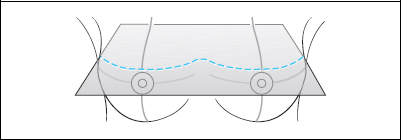

Ultrasound
Mammography
MR Mammography
MRM score | Finding | Points |
Shape | irregular | 1 |
Border | ill-defined | 1 |
CM Distribution | ring | 2 |
Initial Signal Intensity Increase | strong | 2 |
Post-initial Signal Intensity Character | plateau | 1 |
MRI score (points) |
| 7 |
MRI BI-RADS |
| 5 |
 Preliminary Diagnosis
Preliminary Diagnosis
Carcinoma (e.g., invasive lobular).
Differential Diagnosis
Focal adenosis.
Clinical Findings | right 1 | left 1 |
Ultrasound | right 4 | left 1 |
Mammography | right 4 | left 1 |
MR Mammography | right 5 | left 1 |
BI-RADS Total | right 5 | left 1 |
Procedure
Since a correlation was suspected between the lesion between the upper quadrants of the right breast, graded BI-RADS 4 in ultrasound, and the lesion detected in MRI, a US-guided core biopsy of the right breast was recommended to obtain histological data.
Histopathology of core biopsy
Invasive lobular carcinoma, grade 2.
Fig. 21.9 US-guided core biopsy. Pre-fire ultrasound image.
Fig. 21.10 MR imaging was performed after US-guided biopsy to confirm the correlation between the US and MRI findings. MRI demonstrated an air bubble (arrow) resulting from the biopsy in the direct neigbourhood of the suspicious lesion in MRI.
Histology
12 mm invasive lobular carcinoma, axillary lymph node status normal.
ILCpT1b, pN0, R0, G2.
Stay updated, free articles. Join our Telegram channel

Full access? Get Clinical Tree


